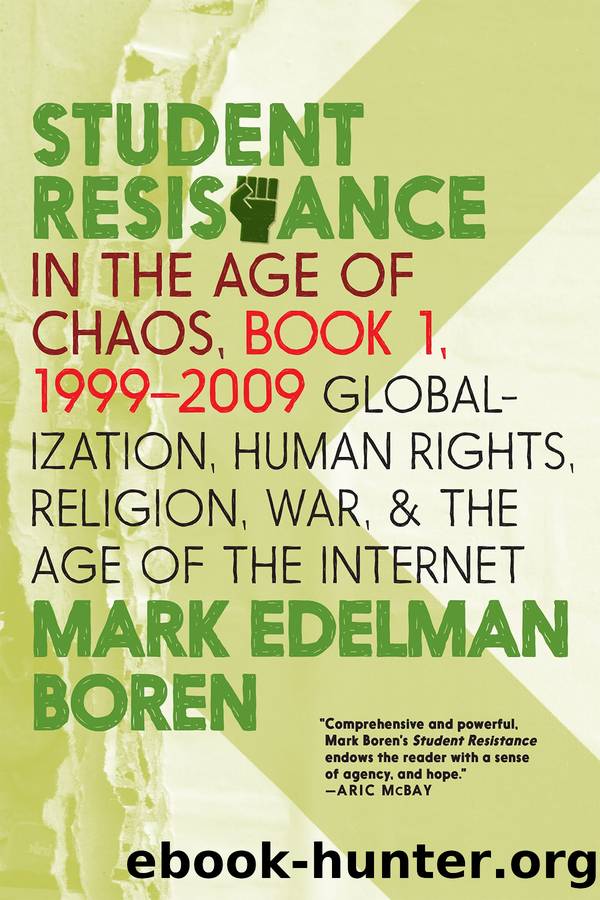Student Resistance in the Age of Chaos. Book 1, 1999-2009 by Mark Edelman Boren

Author:Mark Edelman Boren [Boren Mark Edelman]
Language: eng
Format: epub
Tags: world history; political science; political philosophy; geopolitics; government; protest; gifts for history buffs; political science books; international politics; historical books; world politics; history; history books; political books; politics; history gifts; history teacher gifts; history buff gifts; history lovers gifts; sociology; military; society; philosophy; culture; historical; christian; foreign policy; cold war; vietnam war; current affairs; reference; economics; war; vampires; international relations; essays
ISBN: 9781644210376
Publisher: Seven Stories Press
Published: 2022-08-10T18:00:00+00:00
5
TECHNOLOGICAL EXPLOSIONS, REVOLUTIONS, AND GENDER JUSTICE MOVEMENTS IN ASIA AND AUSTRALIA
Asia during the first decade of the millennium was, like Eastern Europe, a hotbed of student resistance, and student protest actions took just about every conceivable form. The regionâs wide variety of cultures, societies, religions, and governments, which had often historically defined themselves in contrast to their neighbors, also influenced one another through an ever-increasing economic globalism, the proliferation of more affordable technology, and the constantly expanding reach of social media. For nations like Australia that had strong ties to the West, studentsâ issues often mirrored those in Europe or the United States. But even in authoritarian nations, the transmission of Western media and culture spread by new technology and networks encouraged the growth of prodemocracy and civil rights movements. Adding to these cultural influences, the prodemocracy revolutions in Eastern Europe inspired hope in many seeking to overthrow their own authoritarian regimes. Such influences were offset or directly countered by robust dictatorial countermeasures. As Chinaâs government consolidated power domestically, its influence spread across the region in aggressive territorial and economic imperialism and through its internet and social-media platforms.
Student resistance has long played a major role in the histories of the regionâs nations, and student-led reforms have changed the courses of the areaâs nations, from China to Japan, from South Korea to India. But in this first decade of the millennium, the technological advances and social interconnectivity spreading throughout the region began to radically transform student resistance in unprecedented ways. Technology changed the nature of how demonstrations occurred and what they were about, for access to global media expanded the reach of Western ideas, exposing relatively isolated areas to contemporary views on civil rights, ideas of social justice, and, of course, fashion. Globally influential popular cultureâfrom pop singers to movie stars, from hairstyles to clothesâfueled the desires and attitudes of a younger generation often willing to challenge their conservative elders, religious codes, and governments in many of the areaâs cultures and societies.
That said, while interconnectivity and globalism aid increased activism levels, and a number of resistance efforts in the regionâs countries sought to engage on international issues, most of the resistance struggles in the region remained localized and country-specific. They mostly had to do with specific nationsâ struggles over their own citizensâ identities, ideas of self-determination, and rights. South Korean students, for example, would protest in giant numbers against Japanâs school-curriculum reforms, but what they were demonstrating against was the national and personally felt slight in Japanâs whitewashing of the crimes its soldiers committed during their early-twentieth-century invasions of Korea. Because the regionâs many societies are so different from one another, and the relations among them so complex, itâs hard to summarize the various student actions beyond saying that a lot was going on and that the nature and efficacy of the protests were changed by rapidly evolving technology. How quickly those changes swept through the various countries of the region depended on the extent of civilian access to modern technology.
In
Download
This site does not store any files on its server. We only index and link to content provided by other sites. Please contact the content providers to delete copyright contents if any and email us, we'll remove relevant links or contents immediately.
Women and Jewish Marriage Negotiations in Early Modern Italy by Howard Tzvi Adelman(409)
Warrior King by Wilbur Smith(366)
18 real-life stories of serial killers and murderers with solved and unsolved killings from the USA, UK, Europe, and beyond. by Ben Oakley(288)
The Battle of Austerlitz by 50minutes(283)
Violence and Emotions in Early Modern Europe by Susan Broomhall;Sarah Finn;(276)
Who's Who in the Zulu War, 1879: The British by Adrian Greaves Ian Knight(273)
The American Crisis by Unknown(268)
Youth, Heroism and War Propaganda: Britain and the Young Maritime Hero, 1745â1820 by D. A. B. Ronald(240)
The Seeker by S. G. MacLean(231)
The Origins of French Absolutism, 1598-1661 by Alan James(221)
The Dutch East India Company and British East India Company: The History and Legacy of the Worldâs Most Famous Colonial Trade Companies by Charles River Editors(213)
The Traitor of Colditz by Robert Verkaik(202)
A Genius for Confusion by Richard M. Fried(201)
Invisible Worlds by Peter Marshall(200)
The Thirty Years War â Complete by Friedrich Schiller(199)
Fires of Faith by Catholic England under Mary Tudor(196)
The Opium Wars: Exploring the Addiction of Empires from Beginning to End by Ramos Adrian & Compacted History(195)
Interest and Connection in the Eighteenth Century by Jacob Sider Jost(194)
The Slave Trade in Africa by Simon Webb;(193)
